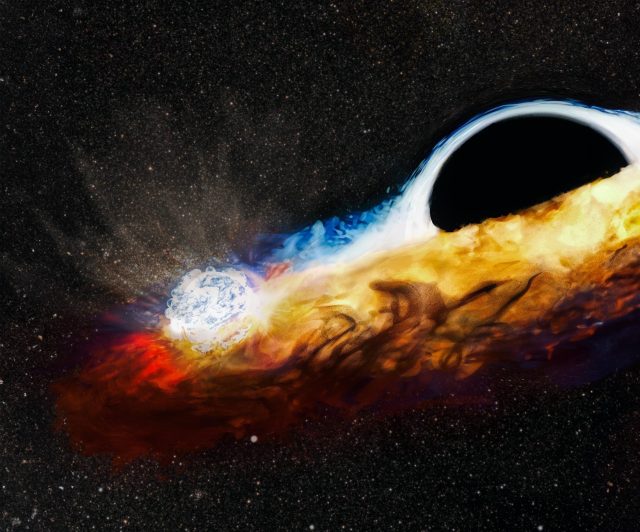
A recent cosmic discovery reveals a black hole tearing apart one star and hurling its remains at another. This event links tidal disruption events and quasi-periodic eruptions, helping astronomers understand black hole environments and shape future research.
- A giant black hole has destroyed one star and now is using that stellar debris to pummel another star or smaller black hole.
- This result helps link two cosmic phenomena that astronomers previously were unsure were unconnected.
- NASA’s Chandra X-ray Observatory and several other telescopes were needed to make this discovery.
- AT2019qiz, the galaxy with the supermassive black hole, is located about 210 million light-years from Earth.
NASA Uncovers Black Hole’s Destructive Behavior
NASA’s Chandra X-ray Observatory, along with other telescopes, has discovered a supermassive black hole that has torn apart one star and is now using the debris from this destruction to bombard another nearby object, likely a star or possibly a smaller black hole. This groundbreaking research links two previously separate cosmic mysteries, shedding light on the environment around some of the largest types of black holes.
An artist’s illustration (below) shows a disk of material—depicted in red, orange, and yellow—that formed after the black hole tore apart a star with its intense tidal forces. Over several years, this disk expanded outward until it intersected with another orbiting object, either a star or a small black hole. Each time this object collides with the disk, it triggers a burst of X-rays, which Chandra has detected. The inset displays Chandra’s X-ray data (in purple) alongside an optical image from Pan-STARRS (in red, green, and blue), highlighting the source.

Discovery of Tidal Disruption Event (TDE)
In 2019, an optical telescope in California detected a flash of light that astronomers later identified as a “tidal disruption event,” or TDE, which occurs when a black hole’s gravitational forces rip a star apart. This TDE was named AT2019qiz by astronomers.
Meanwhile, scientists were also tracking instances of another type of cosmic phenomena occasionally observed across the Universe. These were brief and regular bursts of X-rays that were near supermassive black holes. Astronomers named these events “quasi-periodic eruptions,” or QPEs.
This latest study gives scientists evidence that TDEs and QPEs are likely connected. The researchers think that QPEs arise when an object smashes into the disk left behind after the TDE. While there may be other explanations, the authors of the study propose this is the source of at least some QPEs.
Chandra and Hubble’s Detailed Observation
In 2023, astronomers used both Chandra and Hubble to simultaneously study the debris left behind after the tidal disruption had ended. The Chandra data were obtained during three different observations, each separated by about 4 to 5 hours. The total exposure of about 14 hours of Chandra time revealed only a weak signal in the first and last chunk, but a very strong signal in the middle observation.
From there, the researchers used NASA’s Neutron Star Interior Composition Explorer (NICER) to look frequently at AT2019qiz for repeated X-ray bursts. The NICER data showed that AT2019qiz erupts roughly every 48 hours. Observations from NASA’s Neil Gehrels Swift Observatory and India’s AstroSat telescope cemented the finding.
Ultraviolet Insights Into the Expanding Disk
The ultraviolet data from Hubble, obtained at the same time as the Chandra observations, allowed the scientists to determine the size of the disk around the supermassive black hole. They found that the disk had become large enough that if any object was orbiting the black hole and took about a week or less to complete an orbit, it would collide with the disk and cause eruptions.
This result has implications for searching for more quasi-periodic eruptions associated with tidal disruptions. Finding more of these would allow astronomers to measure the prevalence and distances of objects in close orbits around supermassive black holes. Some of these may be excellent targets for the planned future gravitational wave observatories.
The paper describing these results was published in the October 9, 2024 issue of the journal Nature. The first author of the paper is Matt Nicholl (Queen’s University Belfast in Ireland).
Reference: “Quasi-periodic X-ray eruptions years after a nearby tidal disruption event” by M. Nicholl, D. R. Pasham, A. Mummery, M. Guolo, K. Gendreau, G. C. Dewangan, E. C. Ferrara, R. Remillard, C. Bonnerot, J. Chakraborty, A. Hajela, V. S. Dhillon, A. F. Gillan, J. Greenwood, M. E. Huber, A. Janiuk, G. Salvesen, S. van Velzen, A. Aamer, K. D. Alexander, C. R. Angus, Z. Arzoumanian, K. Auchettl, E. Berger, T. de Boer, Y. Cendes, K. C. Chambers, T.-W. Chen, R. Chornock, M. D. Fulton, H. Gao, J. H. Gillanders, S. Gomez, B. P. Gompertz, A. C. Fabian, J. Herman, A. Ingram, E. Kara, T. Laskar, A. Lawrence, C.-C. Lin, T. B. Lowe, E. A. Magnier, R. Margutti, S. L. McGee, P. Minguez, T. Moore, E. Nathan, S. R. Oates, K. C. Patra, P. Ramsden, V. Ravi, E. J. Ridley, X. Sheng, S. J. Smartt, K. W. Smith, S. Srivastav, R. Stein, H. F. Stevance, S. G. D. Turner, R. J. Wainscoat, J. Weston, T. Wevers and D. R. Young, 9 October 2024, Nature.
DOI: 10.1038/s41586-024-08023-6
NASA’s Marshall Space Flight Center manages the Chandra program. The Smithsonian Astrophysical Observatory’s Chandra X-ray Center controls science operations from Cambridge, Massachusetts, and flight operations from Burlington, Massachusetts.




